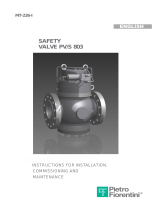
VectiosTM PJ
EN-11
7 - POSITIONING AND INSTALLATION
Minimum area for indoor air distribution
(R-454B refrigerant)
The unit with refrigerant R-454B (A2L fl uid) needs a minimum
surface in the room where the air supplied by its indoor circuit
will be distributed, according to EN-378-1:
Important: It is the customer’s responsibility to carry out the
risk analysis of the installation and, as a result of that analysis,
to take the necessary measures according to standard EN-
378-1. Consult the recommendations given in the “A2L rooftop
installation guide” (Nb. 10714).
IPJ 0090 0120 0140 0160 0180 0190
Refrigerant charge per
circuit (kg) 7,20 7,47 9,90 9,90 10,17 10,44
Minimum area (m2)34,5 37,1 65,2 65,2 68,8 72,5
IPJ 0200 0220 0240 0280 0320 0360 0380
Refrigerant charge per
circuit (kg) 5,63 5,76 5,85 9,00 9,14 9,14 9,23
Minimum area (m2)21,0 22,1 22,8 53,9 55,5 55,5 56,6
Sound Level
These units are designed to work with a low acoustic level. In any
case, the following must be taken into account for the design of
the installation: the outdoor environment for acoustic radiation,
the type of building for the noise transmitted by air, the solid
elements for the transmission of vibrations.
To reduce transmission through solid surfaces to the maximum, it
is very advisable to install shock absorbers between the ground
or structure and the unit frame. If necessary, a study must be
commissioned to an acoustic technician.
Sound power level (LW)
Sound pressure level (LP)
Measurement conditions: in a clear fi eld, measured at a distance
of 10 metres, directivity 2 and at 1,5 metres from the ground.
Note: The sound pressure level depends on the installation
conditions and, as such, it only indicated as a guide. Values
obtained according to the ISO 3744 standard.
RPJ / IPJ 0090 0120 0140 0160 0180 0190 0200
Total dB(A) 45,8 50,3 50,8 50,8 51,3 52,3 53,1
RPJ / IPJ 0220 0240 0280 0320 0360 0380 0400
Total dB(A) 53,7 54,2 54,2 54,1 54,1 54,6 56,1
RPJ / IPJ 0090 0120 0140 0160 0180 0190 0200
63 Hz 55,2 60,8 61,4 60,9 61,3 63,1 64,3
125 Hz 64,2 66,7 68,9 66,1 70,0 71,1 69,6
250 Hz 71,8 74,8 76,1 72,9 76,3 76,4 77,0
500 Hz 70,2 76,7 76,4 76,8 77,1 78,3 79,5
1000 Hz 72,0 76,2 76,3 77,5 77,3 78,2 79,4
2000 Hz 69,7 73,5 74,3 75,3 74,1 75,5 77,0
4000 Hz 62,6 69,2 70,3 70,6 70,4 72,2 73,1
8000 Hz 59,0 63,7 65,5 65,8 65,6 67,5 67,9
Total dB(A) 77,5 82,0 82,5 82,5 83,0 84,0 85,0
RPJ / IPJ 0220 0240 0280 0320 0360 0380 0400
63 Hz 64,5 64,9 64,8 64,6 64,6 65,3 66,8
125 Hz 69,9 71,5 72,4 71,3 71,4 74,0 75,5
250 Hz 77,7 78,9 79,7 78,4 77,9 79,3 80,8
500 Hz 80,1 80,4 79,9 80,1 80,2 80,9 82,4
1000 Hz 79,9 80,2 79,8 80,4 80,6 80,7 82,2
2000 Hz 77,4 77,8 77,7 78,3 78,1 77,7 79,2
4000 Hz 73,4 73,7 73,8 73,9 74,2 74,4 75,9
8000 Hz 68,2 68,6 68,9 69,1 69,4 69,6 71,1
Total dB(A) 85,5 86,0 86,0 86,0 86,0 86,5 88,0
These units are equipped as standard with a leak detector that
from a certain concentration of gas (parametrizable) activates
a PROTECTION MODE until the mitigation of the leak (see the
chapter on “Safety elements”.
This indication is only here to help our customer to identify the
limits of the fl ammability risk.
But there is no risk of explosion linked to the used of A2L
refrigerant due to the machine itself.
Note (the following information is provided by the manufacturer
exclusively for informational purposes. The application of the
following directives relies exclusively upon the user):
According to directives 2009/104/EC and 1999/92/EC, these
zones might be qualifi ed by the user as ATEX Zone based on
the user’s own risk analysis for which the user remains solely
responsible. According to the defi nition of Annex I of directive
1999/92/EC, this zone might be classifi ed Zone 2 because it
might be a place in which an explosive atmosphere consisting
of a mixture of air with fl ammable substances in the form of gas
is not likely to occur in normal operation but, if it does occur, will
persist for a short period only.
In case an additional equipment is necessary (motorized valve,
pump, etc.…), it must be:
● installed out of defi ned potentially fl ammable zone;
● qualifi ed as a non-ignition source for the fl uid used.
0,6m
0,6m
0,6m
0,6m
IPJ 0200 - 0380





















